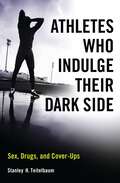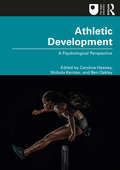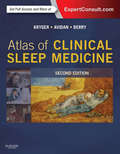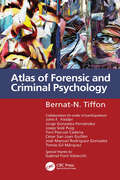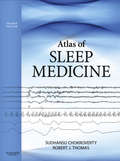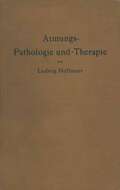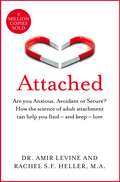- Table View
- List View
Athletes Who Indulge Their Dark Side: Sex, Drugs, and Cover-Ups (Non-ser.)
by Stanley H. TeitelbaumA leading psychologist explores the phenomenon of athletes across the sports world who engage in high-risk behavior that often destroys lives, bodies, and reputations.From sex and drugs to violence, gambling, and wholesale conspiracies, scandals are everywhere in sports. Each of these problems is its own issue, and every case is separate, but taken as a whole this criminal pathology is indicative of a widespread problem with athletes and responsibility. In this wide-ranging and deep-seeking investigation, psychologist Stanley H. Teitelbaum asks why elite athletes take enormous risks with their lives and careers. Teitelbaum analyzes and diagnoses this culturally resonant set of problems with an honest, critical eye, looking at everything from baseball's steroid abusers to gambling scandals in the NBA to the steady stream of athletes arrested for domestic violence to the murder trials of O.J. Simpson and wrestler Chris Benoit. A concluding chapter holds sports commissioners and others to task for hiding behind a façade of ignorance and duplicitous naïveté in attempting to cover up or defuse brewing scandals.
The Athletic Brain
by Kenneth M. HeilmanMany parts of the athlete’s body are important for performance, such as strong muscles and bones; healthy lungs and heart; and several sensory systems, including the vision, touch, and joint position senses, and the vestibular system for balance. However, the critical element for athletic performance is, "not what you have but how you use it." The organ that decides "how you use it" is the brain. This book explains how the brain allows the athlete to perform. The book starts with an outline of brain anatomy, which is necessary to understand how the brain functions. The book then outlines many critical aspects of the athlete’s brain, including learning motor skills; decision-making; hand preference; visual perception of speed, distance, and direction; balance; emotions and mood. Finally, the book discusses the adverse influence of brain injuries.
The Athletic Brain
by Kenneth M. HeilmanMany parts of the athlete’s body are important for performance, such as strong muscles and bones; healthy lungs and heart; and several sensory systems, including the vision, touch, and joint position senses, and the vestibular system for balance. However, the critical element for athletic performance is, "not what you have but how you use it." The organ that decides "how you use it" is the brain. This book explains how the brain allows the athlete to perform. The book starts with an outline of brain anatomy, which is necessary to understand how the brain functions. The book then outlines many critical aspects of the athlete’s brain, including learning motor skills; decision-making; hand preference; visual perception of speed, distance, and direction; balance; emotions and mood. Finally, the book discusses the adverse influence of brain injuries.
Athletic Development: A Psychological Perspective
by Caroline Heaney; Nichola Kentzer; Ben OakleyAthletic Development: A Psychological Perspective is an examination of the psychological factors that help or hinder the development of participants in sport. This includes influences such as families, coach-athlete interactions, and transitional episodes on an individual’s pathway in sport. This edited collection of topical chapters shines a unique psychological perspective on the athlete’s development through sport. It explores a range of contemporary themes that influence athlete’s development including: An introduction to athletic development which orientates a holistic, psychological perspective of the athletic development process. Social influences on athletic development, which explores the impact of varied social influences (e.g., coach, family, peers, school) on sports participation and performance from a psychological perspective. Athlete wellbeing, which explores various aspects influencing mental health and welfare as an athlete progresses through their sports career. The book combines key theory with illustrative case studies, to analyse the complexities of athletic development. It takes a critical perspective highlighting some of the debates and controversies in these areas and uses spotlight boxes in each chapter to focus on questions or topics of particular interest. Athletic Development: A Psychological Perspective is a key reader for all students in the fields of sport and exercise psychology, sport coaching, and related sport science subjects.
Athletic Development: A Psychological Perspective
by Caroline Heaney Nichola Kentzer Ben OakleyAthletic Development: A Psychological Perspective is an examination of the psychological factors that help or hinder the development of participants in sport. This includes influences such as families, coach-athlete interactions, and transitional episodes on an individual’s pathway in sport. This edited collection of topical chapters shines a unique psychological perspective on the athlete’s development through sport. It explores a range of contemporary themes that influence athlete’s development including: An introduction to athletic development which orientates a holistic, psychological perspective of the athletic development process. Social influences on athletic development, which explores the impact of varied social influences (e.g., coach, family, peers, school) on sports participation and performance from a psychological perspective. Athlete wellbeing, which explores various aspects influencing mental health and welfare as an athlete progresses through their sports career. The book combines key theory with illustrative case studies, to analyse the complexities of athletic development. It takes a critical perspective highlighting some of the debates and controversies in these areas and uses spotlight boxes in each chapter to focus on questions or topics of particular interest. Athletic Development: A Psychological Perspective is a key reader for all students in the fields of sport and exercise psychology, sport coaching, and related sport science subjects.
Atlas and the Globe: The Summits of Philosophy
by Giuseppe RoncoroniThis book is an anthology of philosophical essays. Its principle is simple: the moments of our life are original. What we perceive and think does not arise from an elusive and illusive entity called God, Soul or External World. This setting, in line with philosophical and scientific trends, is the starting point for reaching a coherent and innovative solution to the problems of knowledge. In the foreground we encounter the relationship between the mind and the brain, where the terms are composed according to the analogy with music and the musical score, and then the basis of time and the sense of the Big Bang. These are the frame and sketch of the book.
Atlas and the Globe: The Summits of Philosophy
by Giuseppe RoncoroniThis book is an anthology of philosophical essays. Its principle is simple: the moments of our life are original. What we perceive and think does not arise from an elusive and illusive entity called God, Soul or External World. This setting, in line with philosophical and scientific trends, is the starting point for reaching a coherent and innovative solution to the problems of knowledge. In the foreground we encounter the relationship between the mind and the brain, where the terms are composed according to the analogy with music and the musical score, and then the basis of time and the sense of the Big Bang. These are the frame and sketch of the book.
Atlas of Brain Mapping: Topographic Mapping of EEG and Evoked Potentials
by Konrad Maurer Thomas DierksFrom its discovery in 1929 by Hans Berger until the late 1960s, when sensory visual and auditory evoked potentials were dis covered and became popular, the EEG was the most important method of neurophysiological examination. W-ith the advent of computer technology in the 1980s, it became possible to plot the potential fields of the EEG onto models of the scalp. This plot ting of information as neuroimages followed the structural and functional techniques of Cf, MRI, PET and SPECf. The success of this method, which began in the early 1980s, has led to the brain mapping of EEGs and EPs being increasingly used for di agnosistic purposes in neurology, psychiatry and psychopharma cology. The pioneers of this method believed in it and were commit ted to its success. However, many traditionalists felt that it gave no new information and so regarded the method with scepticism. Some found both the coloured maps and the mapping technique misleading, which led to unnecessary conflict between mappers and their chromophobic oponents. Emotions have run so high that some professional bodies have justifiably adopted guidelines and warned of the misuse of the method.
Atlas of Clinical Sleep Medicine E-Book: Expert Consult - Online
by Meir H. Kryger2014 BMA Medical Book Awards Highly Commended in Internal Medicine category! Accurately diagnose and treat adult and pediatric sleep disorders with exceptional visual guidance from world-renowned sleep expert Dr. Meir H. Kryger. Atlas of Clinical Sleep Medicine is an easy-to-read, highly illustrated atlas that details the physiologic, clinical, morphologic, and investigational aspects of the full range of sleep disorders you encounter in everyday practice -- and helps you interpret the visual manifestations of your patients' sleep disorders so you can manage them most effectively. ".. a nice addition to your library and a powerful teaching tool in a training program." Reviewed by Sleep Breath, Oct 2014 "As a regular teacher on the same range of sleep disorders, one of its best features is excellent online access (to all the pictures, graphs, polysomnography traces and patient videos)." Reviewed by Advances in Clinical Neuroscience and Rehabilitation (ANCR), Jan 2015Visually grasp how sleep affects each body system thanks to a full-color compendium that correlates the physiology of sleep with the relevant findings. Determine the best and most up-to-date drug therapy with information about the latest drugs available as well as those in clinical trials.Compare your patients’ polysomnograms to a wealth of high-quality recordings taken from the latest machines used by institutions around the world.Score, interpret, and diagnose sleep disorders employing the scoring rules from the latest AASM scoring manual.Stay current with the latest on sleep and psychiatric disease, circadian desynchrony, dreaming, insomnia, home sleep testing, new sleep apnea treatments, and more.Understand the correlation between sleep and other health issues – such as stroke and heart failure.Find diagnostic and treatment information quickly and easily thanks to a highly illustrated, easy-to-read format that highlights key details.Access the fully searchable text as well as all of the book’s illustrations, more than 20 patient interview videos, over 40 sleep lab videos, and 200-plus polysomnogram fragments at Expert Consult.
Atlas of Electroencephalography in Sleep Medicine
by Hrayr P. Attarian Nidhi S UndeviaSleep Medicine is a field that attracts physicians from a variety of clinical backgrounds. As a result, the majority of sleep specialists who interpret sleep studies (PSG) do not have specialized training in neurophysiology and electroencephalography (EEG) interpretation. Given this and the fact that PSGs usually are run at a third of the speed of EEGs and that they usually have a limited array of electrodes, waveforms frequently appear different on the PSGs compared to the EEGs. This can lead to challenges interpreting certain unusual looking activity that may or may not be pathological. This Atlas of Electroencephalograpy in Sleep Medicine is extensively illustrated and provides an array of examples of normal waveforms commonly seen on PSG, in addition to normal variants, epileptiform and non-epileptiform abnormalities and common artifacts. This resource is divided into five main sections with a range of topics and chapters per section. The sections cover Normal Sleep Stages; Normal Variants; Epileptiform Abnormalities; Non-epileptiform Abnormalities; and Artifacts. Each example includes a brief description of each EEG together with its clinical significance, if any. Setting the book apart from others in the field is the following feature: Each EEG discussed consists of three views of the same page -- one at a full EEG montage with 30mm/sec paper speed, the same montage at 10mm/sec (PSG speed) and a third showing the same thing at 10 mm/sec, but with the abbreviated PSG montage. Unique and the first resource of its kind in sleep medicine, the Atlas of Electroencephalograpy in Sleep Medicine will greatly assist those physicians and sleep specialists who read PSGs to identify common and unusual waveforms on EEG as they may appear during a sleep study and serve as a reference for them in that capacity.
Atlas of Forensic and Criminal Psychology
by Bernat-N. TiffonOriginally published in Spanish in 2017 by Libreria Bosch, Barcelona, the Atlas of Forensic and Criminal Psychology is a one-of-kind book made available in English for the first time. This unique work is highly illustrated with full-color images, providing a medico-legal examination of forensic pathology as it relates to cases of forensic psychological interest. The book begins with a historical perspective and includes images of patients to familiarize the reader with symptoms, the hazard-risk criteria, lethality, and suicidal rescue—research that Dr. Tiffon has addressed in his previous publications. Chapters present photographic records of cases to deepen forensic, psychologist, and medico-legal professionals’ insight into thoughts, behaviors, and mechanisms of self- and hetero-aggressiveness. Such cases illustrate the outcomes of various disorders manifested in individuals and victims; as such, they provide an understanding of the psychological-legal conclusions reached in such cases in order to adapt the legal and preventative measures for specific situations. Coverage includes affective, schizophrenic, and personality disorders as contributing elements in diagnostic judgments, noting the great difficulty such examples present to experts performing psychopathological evaluations after criminal, and often violent, events have occurred. Various psychopathological disorders are addressed as well as the technical treatment that should occur in each case from a psychological-forensic perspective. Features: • Presents a provocative look at various syndromes familiar to forensic psychologists, as applied to criminal cases and the pathology of suicide victims and homicide perpetrators • Combines the work of world-renowned expert contributors to examine the criminal, legal, and psychological facets of various diagnoses and case examples • Offers insight into the psychological state of suicide victims, considering their state of mind as a "psychological autopsy" In his previous books published in Spanish, Manual of Consulting in Psychology and Clinical, Legal, Legal, Criminal, and Forensic Psychopathology (2008), Manual of Professional Performance in Clinical, Criminal, and Forensic Psychopathology (2009), and the 4-volume Practical Criminological Atlas of Forensic Psychometry (2019-2020), Tiffon approached forensic psychology and psychopathology from a theoretical perspective. In the Atlas of Forensic and Criminal Psychology, his first book translated into English, Tiffon expands on these prior works, serving to provide a visual reference and guide to medical pathologists and consulting psychologists in cases of disorders in which psychopathological mutilation, injury, and self-injury occur.
Atlas of Forensic and Criminal Psychology
by Bernat-N. TiffonOriginally published in Spanish in 2017 by Libreria Bosch, Barcelona, the Atlas of Forensic and Criminal Psychology is a one-of-kind book made available in English for the first time. This unique work is highly illustrated with full-color images, providing a medico-legal examination of forensic pathology as it relates to cases of forensic psychological interest. The book begins with a historical perspective and includes images of patients to familiarize the reader with symptoms, the hazard-risk criteria, lethality, and suicidal rescue—research that Dr. Tiffon has addressed in his previous publications. Chapters present photographic records of cases to deepen forensic, psychologist, and medico-legal professionals’ insight into thoughts, behaviors, and mechanisms of self- and hetero-aggressiveness. Such cases illustrate the outcomes of various disorders manifested in individuals and victims; as such, they provide an understanding of the psychological-legal conclusions reached in such cases in order to adapt the legal and preventative measures for specific situations. Coverage includes affective, schizophrenic, and personality disorders as contributing elements in diagnostic judgments, noting the great difficulty such examples present to experts performing psychopathological evaluations after criminal, and often violent, events have occurred. Various psychopathological disorders are addressed as well as the technical treatment that should occur in each case from a psychological-forensic perspective. Features: • Presents a provocative look at various syndromes familiar to forensic psychologists, as applied to criminal cases and the pathology of suicide victims and homicide perpetrators • Combines the work of world-renowned expert contributors to examine the criminal, legal, and psychological facets of various diagnoses and case examples • Offers insight into the psychological state of suicide victims, considering their state of mind as a "psychological autopsy" In his previous books published in Spanish, Manual of Consulting in Psychology and Clinical, Legal, Legal, Criminal, and Forensic Psychopathology (2008), Manual of Professional Performance in Clinical, Criminal, and Forensic Psychopathology (2009), and the 4-volume Practical Criminological Atlas of Forensic Psychometry (2019-2020), Tiffon approached forensic psychology and psychopathology from a theoretical perspective. In the Atlas of Forensic and Criminal Psychology, his first book translated into English, Tiffon expands on these prior works, serving to provide a visual reference and guide to medical pathologists and consulting psychologists in cases of disorders in which psychopathological mutilation, injury, and self-injury occur.
Atlas of Psychiatric Pharmacotherapy
by Roni Shiloh Rafael Stryjer Abraham Weizman David J. NuttThe second edition of this exceptional book provides a comprehensive understanding of the mechanisms of action involved in psychiatric pharmacotherapy. Using imaginative colourful double-page spreads, this exceptional book presents state-of-the-art information on all the basic principles of psychiatric pharmacotherapy, abused substances, drug inter
Atlas of Psychiatry
by Waguih William IsHakThis atlas is the first fully visual reference to cover psychiatry broadly, appealing to psychiatric as well as non-psychiatric clinicians and trainees who need an easy-to-use visual resource with holistic approach to patient care. Written by expert clinicians and educators, this text describes basic clinical and scholarly information across the field utilizing an easy-to-understand format. The rich figures and tables describe etiology, pathophysiology, phenomenology, and treatment even in areas that are difficult to illustrate, including substance-related disorders, neurodegenerative diseases, personality disorders, and others. The visual approach proves valuable to some of the most innovative techniques in psychiatry, including implications for neuroimaging. Comprehensive and unique, Atlas of Psychiatry is a landmark reference for all medical practitioners looking for an intricate yet accessible visual resource.
Atlas of Sleep Medicine
by Lois E. Krahn Timothy I. Morgenthaler Michael H. SilberWritten by experienced contributors from the renowned Mayo Clinic, the Atlas of Sleep and Sleep Medicine covers the history, humanities, and comparative biological aspects of sleep. This highly illustrated resource includes photographs, reproductions, graphics, segments of sleep studies, and clinical algorithms to aid the clinician in the correct d
Atlas of Sleep Medicine
by Robert J. Thomas Sushanth Bhat Sudhansu ChokrovertyThis authoritative and updated Atlas provides a comprehensive span of topics across all of sleep medicine, including old to futuristic approaches. It captures the significant changes and advances in the field and a wealth of new visual information available since the last edition. Edited and contributed by leaders in the art and science of sleep medicine, the Atlas highlights how the field of sleep medicine is truly a mix of several medical specialties. The field continues to rapidly evolve with research leading to some future directions. This Atlas remains a standard reference for Sleep Physicians, including Sleep Fellows and other trainees in Sleep Medicine, Sleep Technologists, and Sleep researchers.
Atlas of Sleep Medicine E-Book: Expert Consult - Online And Print
by Sudhansu Chokroverty Robert J. Thomas Meeta BhattEffectively diagnose and manage adult and pediatric sleep disorders with help from Atlas of Sleep Medicine, the most comprehensive and detailed source of pictorial and video guidance available. A full-color design with an entirely new image collection and video segments facilitates the observation and interpretation of sleep-related events and recordings. Whether you are preparing for the sleep medicine fellowship examination, or simply want to offer your patients today's best care, this sleep medicine book is an ideal resource!Consult this title on your favorite device, conduct rapid searches, and adjust font sizes for optimal readability. Confidently treat sleep-related breathing disorders with a practical step-by-step approach to positive pressure titration, summarizing merits, demerits, dangers, and limitations. Observe, evaluate, and treat unusual, uncommon, and often unrecognized PSG patterns.See how clinical and PSG findings correlate in real time for various sleep disorders by watching video segments (new to this edition!) that show sleep movements and polysomnography data side by side.Visually reinforce your understanding of circadian dysrhythmias through dynamic hypnograms and a tantalizing pictorial display. Evaluate indications and choose appropriate dental appliances with step-by-step instruction and supporting video clips.Address undesired phenomena that occur in association with sleep with eight new unique vignettes with associated videos including a variety of parasomnias, cataplexy, and death from obstructive sleep apnea. Access the fully searchable text online including the complete image library, over two dozen videos, and more at Expert Consult.
Atmosphere and Aesthetics: A Plural Perspective (Ambiances, Atmospheres And Sensory Experiences Of Spaces Ser.)
by Tonino Griffero Marco TedeschiniThis book provides a presentation of the concept of “atmosphere” in the realm of aesthetics. An “atmosphere” is meant to be an emotional space. Such idea of “atmosphere” has been more and more subsumed by human and social sciences in the last twenty years, thereby becoming a technical notion. In many fields of the Humanities, affective life has been reassessed as a proper tool to understand the human being, and is now considered crucial. In this context, the link between atmospheres and aesthetics becomes decisive. Nowadays, aesthetics is no longer only a theory of art, but has recovered its original vocation: to be a general theory of perception conceived of as an ordinary experience of pre-logical character. In its four parts (Atmospheric turn?, Senses and Spaces, Subjects and Communities, Aesthetics and Art Theory), this volume discusses whether atmospheres could take the prominent and paradigmatic position previously held by art in order to make sense of such sensible experience of the world.
Atmungs-Pathologie und -Therapie
by Ludwig HofbauerDieser Buchtitel ist Teil des Digitalisierungsprojekts Springer Book Archives mit Publikationen, die seit den Anfängen des Verlags von 1842 erschienen sind. Der Verlag stellt mit diesem Archiv Quellen für die historische wie auch die disziplingeschichtliche Forschung zur Verfügung, die jeweils im historischen Kontext betrachtet werden müssen. Dieser Titel erschien in der Zeit vor 1945 und wird daher in seiner zeittypischen politisch-ideologischen Ausrichtung vom Verlag nicht beworben.
Atom and Archetype: The Pauli/Jung Letters, 1932-1958
by C. G. Jung Wolfgang Pauli C. A. Meier David Roscoe Beverley ZabriskieIn 1932, world-renowned physicist Wolfgang Pauli had already done the work that would win him the 1945 Nobel Prize. He was also suffering after a series of troubling personal events. He was drinking heavily, quarrelling frequently, and experiencing powerful, disturbing dreams. Pauli turned to C. G. Jung for help, forging an extraordinary intellectual conjunction not just between a physicist and a psychologist but between physics and psychology. As their acquaintance developed, Jung and Pauli discussed the nature of dreams and their relation to reality, finding surprising common ground between depth psychology and quantum physics and profoundly influencing each other's work.This portrait of an incredible friendship will fascinate readers interested in psychology, science, creativity, and genius.
The Atomic Components of Thought
by John R. Anderson Christian J. LebiereThis book achieves a goal that was set 25 years ago when the HAM theory of human memory was published. This theory reflected one of a number of then-current efforts to create a theory of human cognition that met the twin goals of precision and complexity. Up until then the standard for precision had been the mathematical theories of the 1950s and 1960s. These theories took the form of precise models of specific experiments along with some informal, verbally-stated understanding of how they could be extended to new experiments. They seemed to fall far short of capturing the breadth and power of human cognition that was being demonstrated by the new experimental work in human cognition. The next 10 years saw two major efforts to address the problems of scope. In 1976, the ACT theory was first described and included a production rule system of procedural memory to complement HAM's declarative memory. This provided a computationally adequate system which was indeed capable of accounting for all sorts of cognition. In 1993, a new version of ACT--ACT-R--was published. This was an effort to summarize the theoretical progress made on skill acquisition in the intervening 10 years and to tune the subsymbolic level of ACT-R with the insights of the rational analysis of cognition. Although the appearance of generally-available, full-function code set off a series of events which was hardly planned, it resulted in this book. The catalyst for this was the emergence of a user community. Lebiere insisted that assembling a critical mass of users was essential to the ultimate success of the theory and that a physical gathering was the only way to achieve that goal. This resulted in the First Annual ACT-R Summer School and Workshop, held in 1994. In writing the book, the authors became seized by an aspiration that went beyond just describing the theory correctly. They decided to try to display what the theory could do by collecting together and describing some of its in-house applications. This book reflects decades of work in ACT-R accumulated by many researchers. The chapters are authored by the people that did that particular work. No doubt the reader will be impressed by the scope of the research and the quality of the individual work. Less apparent, but no less important, was the effort that everyone put into achieving the overall consistency and technical integrity of the book. This is the first work in cognitive science to precisely model such a wide range of phenomena with a single theory.
The Atomic Components of Thought
by John R. Anderson Christian J. LebiereThis book achieves a goal that was set 25 years ago when the HAM theory of human memory was published. This theory reflected one of a number of then-current efforts to create a theory of human cognition that met the twin goals of precision and complexity. Up until then the standard for precision had been the mathematical theories of the 1950s and 1960s. These theories took the form of precise models of specific experiments along with some informal, verbally-stated understanding of how they could be extended to new experiments. They seemed to fall far short of capturing the breadth and power of human cognition that was being demonstrated by the new experimental work in human cognition. The next 10 years saw two major efforts to address the problems of scope. In 1976, the ACT theory was first described and included a production rule system of procedural memory to complement HAM's declarative memory. This provided a computationally adequate system which was indeed capable of accounting for all sorts of cognition. In 1993, a new version of ACT--ACT-R--was published. This was an effort to summarize the theoretical progress made on skill acquisition in the intervening 10 years and to tune the subsymbolic level of ACT-R with the insights of the rational analysis of cognition. Although the appearance of generally-available, full-function code set off a series of events which was hardly planned, it resulted in this book. The catalyst for this was the emergence of a user community. Lebiere insisted that assembling a critical mass of users was essential to the ultimate success of the theory and that a physical gathering was the only way to achieve that goal. This resulted in the First Annual ACT-R Summer School and Workshop, held in 1994. In writing the book, the authors became seized by an aspiration that went beyond just describing the theory correctly. They decided to try to display what the theory could do by collecting together and describing some of its in-house applications. This book reflects decades of work in ACT-R accumulated by many researchers. The chapters are authored by the people that did that particular work. No doubt the reader will be impressed by the scope of the research and the quality of the individual work. Less apparent, but no less important, was the effort that everyone put into achieving the overall consistency and technical integrity of the book. This is the first work in cognitive science to precisely model such a wide range of phenomena with a single theory.
Atomic Habits: the life-changing million-copy #1 bestseller
by James ClearTHE PHENOMENAL INTERNATIONAL BESTSELLER: OVER 15 MILLION COPIES SOLD WORLDWIDETransform your life with tiny changes in behaviour, starting now.People think that when you want to change your life, you need to think big. But world-renowned habits expert James Clear has discovered another way. He knows that real change comes from the compound effect of hundreds of small decisions: doing two push-ups a day, waking up five minutes early, or holding a single short phone call.He calls them atomic habits.In this ground-breaking book, Clears reveals exactly how these minuscule changes can grow into such life-altering outcomes. He uncovers a handful of simple life hacks (the forgotten art of Habit Stacking, the unexpected power of the Two Minute Rule, or the trick to entering the Goldilocks Zone), and delves into cutting-edge psychology and neuroscience to explain why they matter. Along the way, he tells inspiring stories of Olympic gold medalists, leading CEOs, and distinguished scientists who have used the science of tiny habits to stay productive, motivated, and happy.These small changes will have a revolutionary effect on your career, your relationships, and your life.________________________________A NEW YORK TIMES AND SUNDAY TIMES BESTSELLER'A supremely practical and useful book.' Mark Manson, author of The Subtle Art of Not Giving A F*ck'James Clear has spent years honing the art and studying the science of habits. This engaging, hands-on book is the guide you need to break bad routines and make good ones.' Adam Grant, author of Originals'Atomic Habits is a step-by-step manual for changing routines.' Books of the Month, Financial Times'A special book that will change how you approach your day and live your life.' Ryan Holiday, author of The Obstacle is the WayNumber 1 Sunday Times Bestseller, May 2023
Attached: Are you Anxious, Avoidant or Secure? How the science of adult attachment can help you find – and keep – love
by Amir Levine Rachel HellerAn insightful look at the science behind love, Attached offers you a road map for building stronger, more fulfilling connections.'A groundbreaking book that redefines what it means to be in a relationship.' – John Gray, PhD., bestselling author of Men Are from Mars, Women Are from VenusIs there a science to love? In this groundbreaking book, psychiatrist and neuroscientist Amir Levine and psychologist Rachel S. F. Heller reveal how an understanding of attachment theory – the most advanced relationship science in existence today – can help us find and sustain love.Pioneered by psychologist John Bowlby in the 1950s, the field of attachment explains that each of us behaves in relationships in one of three distinct ways:Anxious people are often preoccupied with their relationships and tend to worry about their partner’s ability to love them back.Avoidant people equate intimacy with a loss of independence and constantly try to minimize closeness.Secure people feel comfortable with intimacy and are usually warm and loving.With fascinating psychological insight, quizzes and case studies, Dr Amir Levine and Rachel Heller help you understand the three attachment styles, identify your own and recognize the styles of others so that you can find compatible partners or improve your existing relationship.
Attaching in Adoption: Practical Tools for Today's Parents
by Deborah D. GrayThis classic text is a comprehensive guide for prospective and actual adoptive parents on how to understand and care for their adopted child and promote healthy attachment. It explains what attachment is and provides parenting techniques matched to children's emotional needs and stages to enhance children's happiness and emotional health.
